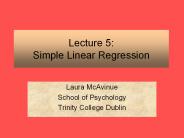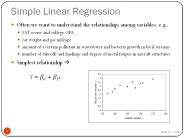Linear Regression - PowerPoint PPT Presentation
Title:
Linear Regression
Description:
Title: Math 326 Mathematics for Decision Making Author: Teacher Last modified by: John Kros Created Date: 8/11/1997 4:49:59 AM Document presentation format – PowerPoint PPT presentation
Number of Views:25
Avg rating:3.0/5.0
Title: Linear Regression
1
Linear Regression
- Outline Linear Regression Analysis
- Linear trend line
- Regression analysis
- Least squares method
- Model Significance
- Correlation coefficient - R
- Coefficient of determination - R2
- t-statistic
- F statistic
2
Linear Trend
- A forecasting technique relating demand to time
- Demand is referred to as a dependent variable,
- a variable that depends on what other variables
do in order to be determined - Time is referred to as an independent variable,
- a variable that the forecaster allows to vary in
order to investigate the dependent variable
outcome
3
Linear Trend
- Linear regression takes on the form
- y a bx
- y demand and x time
- A forecaster allows time to vary and investigates
the demands that the equation produces - A regression line can be calculated using what is
called the least squares method
4
Why Linear Trend?
- Why do forecasters chose a linear relationship?
- Simple representation
- Ease of use
- Ease of calculations
- Many relationships in the real world are linear
- Start simple and eliminate relationships which do
not work
5
Least Squares Method
- The parameters for the linear trend are
calculated using the following formulas - b (slope) (?xy - n x y )/(?x2 - nx 2)
- a y - b x
- n number of periods
- x ?x/n average of x (time)
- y ?y/n average of y (demand)
6
Correlation
- A measure of the strength of the relationship
between the independent and dependent variables - i.e., how well does the right hand side of the
equation explain the left hand side - Measured by the the correlation coefficient, r
- r (n ?xy - ?x ?y)/(n ?x2 - (?x)2 )(n ?y2 -
(?y)20.5
7
Correlation
- The correlation coefficient can range from
- 0.0 lt r lt 1.0
- The higher the correlation coefficient the
better, e.g.,
8
Correlation
- Another measure of correlation is the coefficient
of determination, r2, the correlation
coefficient, r, squared - r2 is the percentage of variation in the
dependent variable that results from the
independent variable - i.e., how much of the variation in the data is
explained by your model
9
Multiple Regression
- A more powerful extension of linear regression
- Multiple regression relates a dependent variable
to more than one independent variables - e.g., new housing may be a function of several
independent variables - interest rate
- population
- housing prices
- income
10
Multiple Regression
- A multiple regression model has the following
general form - y ?0 ?1x1 ?2x2 .... ?nxn
- ?0 represents the intercept and
- the other ?s are the coefficients of the
contribution by the independent variables - the xs represent the independent variables
11
Multiple Regression Performance
- How a multiple regression model performs is
measured the same way as a linear regression - r2 is calculated and interpreted
- A t-statistic is also calculated for each ? to
measure each independent variables significance - The t-stat is calculated as follows
- t-stat ?i/sse?i
12
F Statistic
- How well a multiple regression model performs is
measured by an F statistic - F is calculated and interpreted
- F-stat ssr2/sse2
- Measures how well the overall model is performing
- RHS explains LHS
13
Least Squares Example
- Calculate the mean of x and the mean of y
- Calculate the slope using the LS formula
- Calculate the intercept using the LS formula
- Plot the LS line and the data
- Interpret the relationship to the data
14
Comparison of LS and Time Series
- Use the same example for lumber sales
- Forecast lumber sales using the linear regression
model developed and the building permit data
supplied - Also forecast using a 3-MA
- Calculate MAD for each method and compare































